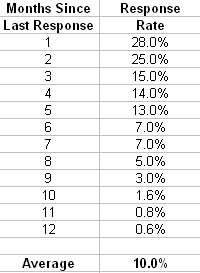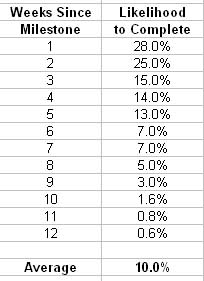Defection Rejection - Part 5
Drilling Down
Newsletter #74 12/2006
Drilling Down - Turning Customer
Data into Profits with a Spreadsheet
*************************
Customer Valuation, Retention,
Loyalty, Defection
Get the Drilling Down Book!
http://www.booklocker.com/jimnovo
Prior Newsletters:
http://www.jimnovo.com/newsletters.htm
========================
In This Issue:
# Topics Overview
# Defection Rejection - Part 5
--------------------
Topics Overview
Hi again folks, Jim Novo here.
In Part 5 of the Defection Rejection series, we take a look at how
to use Recency or Latency "tripwire" data to increase the
productivity of customer marketing efforts. If you're new to
this newsletter, you can check out the other parts of the series here:
Part 1
Part 2
Part 3
Part 4
There are no article links for you this month since all the trade
writers use December to predict what will happen next year. I'm
sure you have already had enough of that...
So let's get directly to the Drillin'!
Questions from Fellow Drillers
=====================
Defection Rejection - Part 5
Recall our sample data sets for tracking customer /
prospect / client behavior
Recency (B2C orientation)

Latency (B2B orientation)

Latency with Frequency (Service orientation)

In effect, what we have done here is create a standardized
methodology for tracking customer / prospect / client behavior using
the behavior-based Recency and Latency
metrics. What this gives you is repeatability and consistency
in your customer marketing programs over time.
The most common frustration people seem to encounter with customer
marketing is the lack of ability to increase ROI on a consistent
basis; results are all over the map. The reason this happens is
usually one of two things:
1. They are trying to construct programs that will influence
behavior but are using non-behavioral variables such as demographics
or firmographics to target the programs. If you want to modify
behavior, use behavioral variables like Recency and Latency.
2. The variables used to construct the program are not able
to be "standardized" in a way that is applicable to all
potential targets. Again, Recency and Latency are by definition
"standardized" and can be applied over and over in the same
way for each test.
In other words, a customer who has not purchased in 3 months is
simply that; it's a firm line in the sand, an easily identified,
clear, unambiguous variable that will consistently produce the same
results when applied to the same population. If you construct a
successful promotion for customers who have not purchased in 3 months,
it will deliver consistent ROI whenever it is applied. If you
are successful at getting people to complete a milestone when they are
3 weeks late but not at 4 weeks late, this will happen each time you
drop the same effort to the same population. If customers can be
saved after four service incidents but not after 5, this will happen
consistently when the same service recovery offer is made to the same
population.
So the challenge is this: how do we optimize this system and figure
out what the most profitable approach is? How do we increase the
productivity of the overall effort?
There are really only two parameters here:
Timing - defined and structured for you by your Recency and
Latency behavioral profiles.
Offer - What is it you are going to offer or do to get the
B2C customer / B2B prospect / Service client to change their
behavior? What is the message and how is it delivered?
Essentially, you have a "grid" (think of a spreadsheet)
where Timing segment is the x-axis and offer is the y-axis. For
each column of Timing segment, there is one best, most profitable
Offer row out of all possible offers that results in highest
profitability. This is why it is incredibly sub-optimal to send
the same discount coupon to everybody on a B2C e-mail or snail mail) list at the same
time.
Sound complicated? Maybe, but the good news is that because
we have built in repeatability and consistency by using
behavioral metrics. Once optimized, the optimized Timing and Offer
combo remains remarkably stable over time given the same target
population. And it's really not as difficult as it sounds.
Let's look at a simple example.
First, classify customers / prospects / clients behaviorally using
Recency or Latency as in the sample data sets above.
Take a 10% random sample of
targets from each segment (every 10th
person in the segment, in the examples above, there are 12 segments), and send all of them a promotion with the
same offer / creative, say 20% off any purchase in the next 30
days, or a bonus for completing the milestone. Make sure you are
tracking response by behavioral segment and not some other
value.
Look at the response rate by behavioral segment.
You will find response falls off significantly as you look at segments further back in
time, or further out from missing the milestone, or higher numbers of
service incidents. You now have
a baseline on response by behavioral segment, and it should look
pretty similar to the examples above. The numbers will be
different, of course, but the performance of the segments relative to
each other should follow a similar pattern.
In addition, you can now predict
the response rate of a customer to this promotion based on what
behavioral segment they are in. The response rates to the same
promotion by segment relative to another segment will always be
similar, barring any major changes in the composition of the customer
base or significant external events. If you can predict
response, you can control results.
Now, the response rate in any
one of the 12 segments above is influenced by the value of
your offer, and both response rate and the cost of the offer have
significant impact on the profitability of your campaign to any
segment.
As offer value increases,
so does response rate, and so do costs. Ideally, you want to find the ideal mix of response rate and
offer value creating the highest profitability for each segment you
promote to.
So, pick any one of the segments from your test above and now
test offer value for the segment.
Letís say you used a 20% discount in the first test.
Pick a segment (say last purchase 3 months ago), and create a 20% random
sample of the segment (every 5th customer) divided into 4
equal test groups. Send
each test group a different discount - say 5%, 10%, 15% and 20%.
Look at your response rates and calculate the profitability for
the 3 month Recency segment at each discount level.
You will find your result looks similar to the following table:
Discount Test :
3 Month Recency Segment
| Customer Sample |
1000 |
1000 |
1000 |
1000 |
| Discount Offer |
5% |
10% |
15% |
20% |
| Response Rate |
2% |
4% |
6% |
8% |
| Responders |
20 |
40 |
60 |
80 |
| Average Price |
$80 |
$80 |
$80 |
$80 |
| Totals Sales |
$1,600 |
$3,200 |
$4,800 |
$6,400 |
| Gross Margin |
30% |
30% |
30% |
30% |
| Gross Profit |
$480 |
$960 |
$1,440 |
$1,920 |
| Discount Cost |
$80 |
$320 |
$720 |
$1,280 |
Net Profit Before
Media Expense |
$400 |
$640 |
$720 |
$640 |
As you can see, the most profitable offer to the 3 Month Recency segment is 15% off. If
you offer 20%, you get a higher response rate but lower profits; any
offer under 15% significantly diminishes response rate.
Repeat this test for each segment, and you will
find the most profitable Timing / Offer combination for each
behavioral segment - your Marketing Productivity
"grid". Impressive, huh? Show it to the CFO next
time you hear grumbling about marketing budgets or accountability.
Yo, CFO, I got your
accountability "right 'ere" (said with your best NYC accent).
The combined effect from
optimizing each behavioral segment will be a significant increase in
profitability as you reduce costs while increasing response. As
customers / prospects / clients move through this system, your
optimized campaigns will automatically compensate to maximize the
value of the customer for where they are in the LifeCycle.
For example, let's say in
a service business you have optimized for the 3 incident, 4 incident,
and 5 incident segments, optimizing in this case meaning achieved the
highest level of post-incident satisfaction by responding in a certain
way. When a 3 incident customer is exposed to another incident,
your response to the 4th incident for this customer is already
optimized to create maximum satisfaction, resulting in an overall gain
relative to responding in the same way to each incident. The
same thing happens if a 5th incident occurs. These gains
compound over time, resulting in a dramatic increase in satisfaction,
because the response is customized to the behavioral profile of the
client, not on a "one-off" reaction to a service
problem. And if you can measure it, you should see a significant
increase in customer retention.
In B2C, if a 3 month
Recent customer does not respond to the optimized promotion for the
segment, the next month they are in the 4 month Recent segment, and
automatically receive a campaign optimized for their behavior, their
place in the LifeCycle.
Discount costs go down as response rates rise. Margins improve
dramatically.
In B2B, if a prospect
misses a milestone and does not respond to a 3 week stimulation to
complete the milestone, they are automatically exposed to an
escalating series of optimized efforts designed to get that milestone
completed and keep the prospect on track.
And of course, since the
determination of the Timing parameter is a simple calculation based on
past behavior, once you have optimized the Offer for each segment,
execution of the entire Marketing Productivity grid can be automated
to run on a monthly basis. Each target is
"re-bucketed" monthly based on current behavior and the
optimal offer is delivered to the target.
That's what I'd call the
right message, to the right target, at the right time.
"Right Time" has always been the most difficult part of this
equation. Using time-based behavioral metrics to trigger
optimized campaign content solves that problem in a consistent,
repeatable way.
Jim
-------------------------------
If you are a consultant, agency, or software developer with clients
needing action-oriented customer intelligence or High ROI Customer
Marketing program designs, click
here
-------------------------------
That's it for this month's edition of the Drilling Down newsletter.
If you like the newsletter, please forward it to a friend! Subscription instructions are top and bottom of this page.
Any comments on the newsletter (it's too long, too short, topic
suggestions, etc.) please send them right along to me, along with any
other questions on customer Valuation, Retention, Loyalty, and
Defection here.
'Til next time, keep Drilling Down!
- Jim Novo
Copyright 2006, The Drilling Down Project by Jim Novo. All
rights reserved. You are free to use material from this
newsletter in whole or in part as long as you include complete
credits, including live web site link and e-mail link. Please
tell me where the material will appear.
| 
![]()



